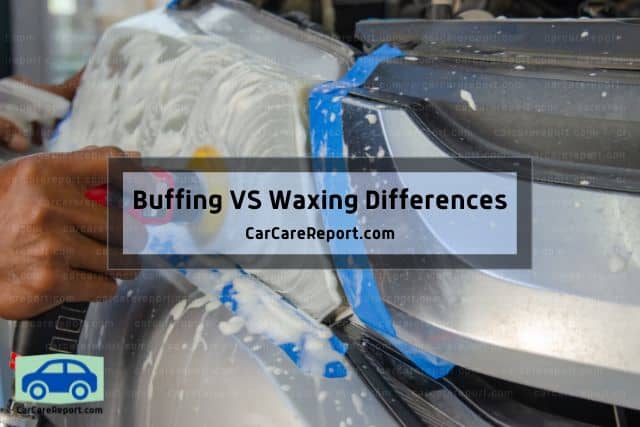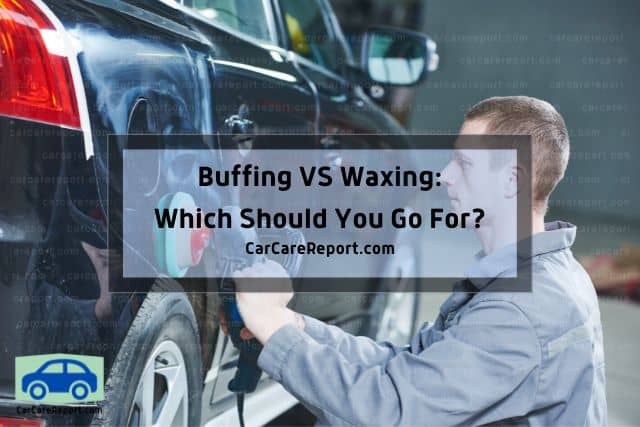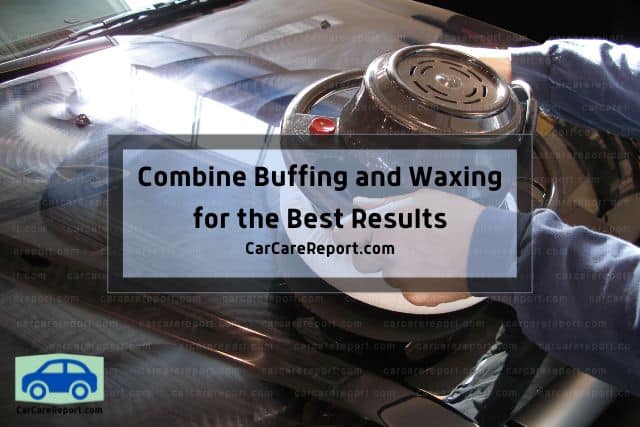Due to the confusion surrounding buffing and waxing a car, many good-intentioned car owners end up making the wrong choice. When treated well, cars can retain their showroom shine, but when subjected to erroneous correction or protection procedures, cars can lose that attractive glow rapidly.

Buffing and waxing are different car detailing options. Waxing is a paint protection option that temporarily shields the vehicle paint from blemishes, radiation, and oxidation. Buffing is a paint correction option that removes imperfections from car paint.
Below, I explain the differences between buffing and waxing a car. I’ll also explain which option to go for depending on your situation and how you can use both buffing and waxing to improve car paint health.
Buffing VS Waxing Differences

Buffing and waxing are some of the simplest and most effective car detailing options available. These somewhat basic processes have several significant differences.
This table summarizes the differences between buffing and waxing a car.
|
Parameter |
Buffing |
Waxing |
|
Purpose |
To remove blemishes from the car’s paint. |
To protect the car’s paint from degradation. |
|
Compounds |
Involves using an abrasive compound to cut the paint’s clear coat. |
Involves the application of wax which acts as a protective layer on the paint. |
|
Effect on Paint |
Removes a small layer of paint while adding shine. |
The protective layer seals the paint and adds gloss to the surface. |
|
Longevity |
Lasts until the paint suffers damage. |
Degrades after several weeks or months, depending on the type of wax applied. |
Purpose
As stated above, the goal of waxing is to protect the car’s paint. It fills in the microscopic cracks in the paint, bonding to the paint surface and insulating it.
Most car wax manufacturers prefer carnauba wax, which they draw from the leaves of Copernicia prunifera, a plant native to Brazil. They prefer carnauba or Brazil wax because it has the following properties:
- Poor adhesion with water.
- A high melting point and resistance to UV radiation.
- Ability to protect and shine.
These elements make waxing a handy paint protection procedure. Wax can withstand extreme weather, including heavy rain or high temperatures, and provides your car with an eye-popping finish. On the other hand, buffing corrects imperfections in the car’s paint.
The paint on your car likely has four layers: e-coat, primer, base coat, and clear coat. Manufacturers apply a thick clear coat to protect the vulnerable base coat that gives the car its color.
The thick clear coat bears the brunt of radiation, poor washing techniques, stains, and light scratching. These imperfections show on the paint’s clear coat, making it look dull.
An easy way to remove blemishes on the clear coat is to remove a thin coating layer through buffing. The technician gently cuts away the damaged clear coat layer using a buffing compound, an applicator pad, or orbital buffer.
The process removes the imperfection, leaving an undamaged transparent layer. You need not worry about removing a layer of clear coat from the car’s surface. In paint terms, the clear coat is quite thick and should withstand buffing several times before needing a repaint.
However, repeated and excessive buffing will degrade the clear coat faster than recommended. Experts advise that you buff your car twice a year at most.
Compounds
Manufacturers usually sell car wax in paste, liquid, or spray form. They blend natural wax with gloss enhancers and protective polymers.
Spray-on waxes are cheap and easy to apply. Liquid waxes are the most common and are equally easy to use. Spray or apply the wax using a microfiber cloth and wipe till the wax is no longer visible. Experts advise that you apply liquid and spray-on wax in sections to ensure thoroughness.
Paste wax, being the thickest option available, typically requires a car buffer for proper application. You’re better off leaving the application of paste work to detailing professionals.
Sometimes people confuse synthetic sealants and car wax. Synthetic sealants are made entirely in laboratories and have no natural products; car wax contains natural wax fused with chemical elements.
The two serve similar functions, but synthetic sealants generally last longer than car wax.
Buffing compounds gently eat away at the car’s paint, removing a thin clear coat layer. Different buffing compounds have different abrasion levels, so you should leave buffing to the experts.
Deep defects require harsh abrasive compounds or prolonged buffing to correct. In such instances, buffing can cause paint damage, primarily when performed by an unskilled person.
Some manufacturers have developed buffing compounds known as diminishing abrasives. These compounds gradually lose their abrasive power as buffing progresses, reducing the likelihood of excessive buffing.
Due to their complexity, buffing compounds are generally more expensive than car waxes.
Effect on Paint
Wax applied sits on the car’s exterior, protecting against weather, dirt, and UV rays. It’s almost like a temporary, clear coating on top of the vehicle. Wax also makes the state of the paint underneath clearer. For instance, waxing makes imperfections, like swirls, more visible.
On the other hand, waxing makes paint with no defects appear brighter and rejuvenated. Therefore, professionals advise that you correct your car’s paint before protecting it via waxing. Unless you insist, a professional detailer won’t wax a car with bad paint. The process highlights the blemishes, making the vehicle appear worse.
Buffing involves the removal of a minuscule layer of clear coat. When light strikes an imperfection on the clear coat, it bounces unevenly on the edges of the blemish, making it visible. Buffing flattens these edges allowing light to pass through uninterrupted.
Buffing compounds often have gloss-enhancing oils that add shine to your car. Unlike wax, these oils don’t protect your car’s paint: their sole role is to make the paint pop.
Longevity
Car waxes may be resistant to water, but they rarely last beyond three months. Car washing and environmental factors contribute to the inevitable degradation of car wax.
Spray waxes, the cheapest and easiest to apply, last between two to four weeks. Paste and liquid waxes last between two to three months.
You’ll struggle to find a carnauba-based product that lasts beyond three months. Synthetic waxes, however, last for as long as a year and can be a handy alternative for someone looking to avoid regular wax applications.
Buffing effects remain until environmental factors, accidents, or poor washing techniques interfere with the clear coat. Buffing only corrects defects; it provides no protection. Therefore, scratches can form immediately after leaving the workshop.
In a perfect world, buffed car paint would remain pristine and glowing. However, this imperfect world contains harmful UV rays, acid rain, rock pebbles, bird poop, substandard car washes, and other elements that will undoubtedly mess up your buffing job.
However, there’s a solution: paint protection. After correcting the paint through buffing, protect it through ceramic coating or waxing.
Buffing VS Waxing: Which Should You Go For?
If you hold any interest in maintaining the showroom looks of your car, understand that you’ll need more than simple car washing. You’ll need to explore paint protection and correction options to properly maintain your car’s paint.

You should go for buffing when you need to correct imperfections like paint swirls and light scratches on your car. Opt for waxing to protect the paint with no defects and make it more vibrant.
If the paint shows no noticeable blemishes, opt for waxing. On the other hand, choose buffing to remove imperfections and scratches. However, you might have trouble telling what exactly your car needs.
Damage to the clear coat is often easy to diagnose. For instance, you can tell if a scratch is superficial (only affecting the clear coat) or not by running your nail over it.
If your nail passes over the scratch without getting stuck, the damage only affects the clear coat and can be rectified by buffing. If you feel your nail catch in the groove, the damage has extended beyond the clear coat and will require repainting.
If you incorrectly pick waxing over buffing, your car won’t receive the detailing it needs, and you’ll seal the paint scratches in place.
One of the threats to clear coat longevity is oxidation caused by acid rain, UV rays, chemical exposure, and animal secretion. Oxidized paint fades and lacks vibrancy, making the car look dull even after a car wash. The solution for faded, oxidized paint is buffing. However, it’s easy to go for waxing, thinking it will restore your car’s shine.
Unfortunately, waxing will only make the dull paint more noticeable. By waxing a car that needs buffing, you’ll make the car look worse. A professional will quickly identify a car that needs buffing and tell you what they can do to improve it.
CarCareReport dot com is owner of this article and was first posted on Sep 19, 2022 and was updated on ..
It’s way easier to identify a car that needs waxing. You should only wax a car that has no paint defects. It’s useless and resource-wasting to wax over paint defects: you’ll waste time and wax on a car that probably needs paint correction before waxing.
Before opting for either waxing or buffing, wash and dry your car in preparation for paint inspection. If the wash exposes superficial paint damage, remedy it through buffing.
It’s possible, even easy, to make the right call between waxing and buffing. However, if you have any doubts, consult a professional detailer.
Combine Buffing and Waxing for the Best Results

Combining paint correction and paint protection will yield the best results. Many professional detailers combine these two techniques to give your vehicle the best possible result. They’ll need to use both together most of the time to remove imperfections in the paint anyway.
Buffing alone restores the vibrancy of car paint but doesn’t protect it from scratches, swirls, and environmental degradation. Waxing insulates the paint and makes it shine, but it only works well on undamaged paint.
Therefore, before waxing a car’s exterior, check if the paint has damage you can fix through buffing. While it’s convenient, it’s inadvisable to buff your vehicle every time you want to wax it.
You Don’t Need to Buff Every Time You Wax
The clear coat on your car degrades every time you subject it to buffing. Experts advise that you buff your car twice a year, even for daily drivers. You can buff your vehicle three times annually if your car goes through abrasive conditions.
You can apply more clear coat layers on the car’s exterior, but there’s no need to risk exposing the vulnerable layers of paint through excessive buffing. If you’re unsure when to buff your car, you can always discuss it with a detailing specialist.
Conversely, you can wax your car as many times as you want. Budget and time constraints can prevent regular waxing but wax away if these factors don’t hinder you.
When To Perform Waxing and Buffing
A convenient system you can use to decide when to wax involves the seasons – wax before every season to ensure that your car’s protected against the different weather elements.
First published on Sep 19, 2022 by CarCareReport.com.
If you live in areas without drastic seasonal changes, waxing every three or four months will provide your car with adequate protection.
You can sync your buffing and waxing schedule to ensure they coincide. For instance, you can buff your car twice a year and apply wax that lasts for six months. Your car’s paint remains protected and shiny throughout the year that way.
Many car owners prefer to take their vehicle to one detailing shop for waxing and buffing. Even if you lose track of when you came in for detailing, the professional will remember. You won’t accidentally over-buff your car that way.
Final Thoughts
Buffing and waxing have different purposes, but they often complement each other. Buffing removes defects on a car’s clear coat while restoring shine. However, the process doesn’t protect the paint.
Waxing protects car paint from degradation and adds luster. However, waxing doesn’t restore damaged color. Combining buffing’s restorative element with waxing’s protective element can guarantee your car paint’s long-term health and vibrancy.
Note that buffing removes a layer of clear coat and can expose vulnerable paint if performed too frequently.
Related Articles
Is Using a Clay Bar Worth It? The Facts Explained
How Much Does It Cost To Wax and Buff Your Car?
4 Important Differences Between Clay Bar Types
How To Remove Rust From a Car Without Sanding
CarCareReport dot com first published this article on Sep 19, 2022..
